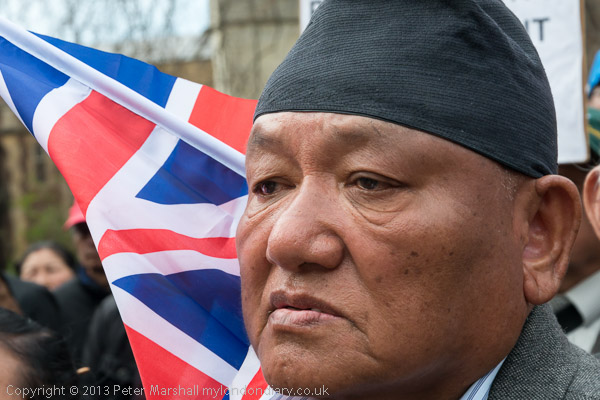
It’s often hard to know why I photograph a particular person, but this man at the protest by Ghurkas opposite the House of Lords had a face I could not pass by. He has a strength and dignity and an expression that to me expresses the disappointment of these people who served in the British Army but have been rather poorly treated by successive British governments. You can read more about their protest in Gurkhas Call for equal treatment. It’s a relic of our colonial past that still embodies the kind of attitudes that were thought acceptable – and indeed hardly questioned – 198 years ago when the army first recruited in Nepal.
One small thing that annoys me about this full-frame – that is uncropped – image is the extra ear at the extreme right. It would be simple to crop while retaining the aspect ratio by taking just a little away from the top and right of the image, and the kind of thing I often do when ‘developing’ my images in Lightroom. Using optical viewfinders – even on DSLRs has seldom if ever been precisely 100% accurate, even on cameras which have claimed this, and the D700 only claims to show approximately 95% of the horizontal and vertical frame coverage – which means that around a tenth of the image area is invisible. Things like this extra ear can creep in and I feel entirely justified in cropping them out, despite my commitment to the uncropped image.
My commitment is not an absolute one and I’m certainly not a purist in this respect. I think trying to work in this way leads to better seeing, but when occasionally I get it entirely wrong I’ll crop if I have to. Very occasionally I’ll even realise I should have framed an image in portrait rather than landscape format and do so after the event. But mostly what I do isn’t really cropping, but a tiny bit of ‘trimming’.
Using the D800E as a DX camera, with the area around the image ‘greyed out’ (CS a6 set to ‘Off’) has several advantages, allowing you to frame in a similar way to using a rangefinder. But also, so far as I can tell, the framing seems 100% accurate. For most purposes the smaller image file at 16Mp is also a benefit, and – at least with FX lenses – you have the choice of switching to a larger 32Mb file for those few cases where it is an advantage. The disadvantage is of course the smaller image size in the viewfinder.
It has always amused me that the staunchest advocates of the uncropped image have been those who have used cameras with some of the least accurate viewfinders. I was a great fan of range-finder cameras, owning and using a number of them over the years – Leica, Konica, Minolta etc, and none of them were particularly precise – and with some lenses spectacularly wrong. And of course even that great photographer and advocate of the full frame – to the extent of producing images including the sprocket holes where he had loaded the film incorrectly – cropped what is perhaps his most famous image.
________________________________________________________
My London Diary : Buildings of London : River Lea/Lee Valley : London’s Industrial Heritage
All photographs on this and my other sites, unless otherwise stated are by Peter Marshall and are available for reproduction or can be bought as prints.
To order prints or reproduce images
________________________________________________________